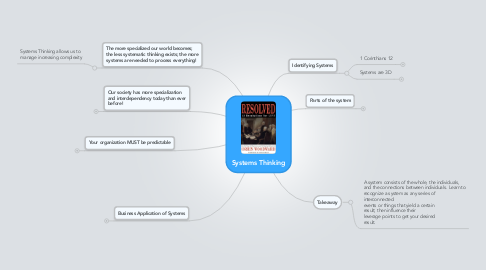
1. The more specialized our world becomes; the less systematic thinking exists; the more systems are needed to process everything!
1.1. Systems Thinking allows us to manage increasing complexity
2. Identifying Systems
2.1. 1 Corinthians 12
2.1.1. A system is a group working in correlation together towards a specific purpose
2.1.1.1. systems thinking is looking at the interconnections between the things themselves
2.1.1.1.1. Minto Pyramid Principle
2.1.2. Truly highlights the distinction between and importance of each individual
2.1.2.1. Lindgren and Shawchuck describe systems theory as a theory that “holds organizational and goal achievement, and the growth of a person and the achievement of their own goals within the organization, to be of equal importance
2.1.2.1.1. All individuals in organization move towards common end goal
2.2. Systems are 3D
2.2.1. We miss them easily because we start by just seeing linearly, (cause and effect)
2.2.1.1. Once we recognize systems and patterns we will look at everything this way.
2.2.2. Magic Eye
2.2.2.1. See past the 2d surface into the 3d picture
2.2.2.2. Our Minds can be trained, just like our eyes, to see the system behind reality as well the linear perspective!
2.2.2.2.1. The subconscious provides solutions in systems thinking.
3. Business Application of Systems
3.1. Proverbs 23:7
3.1.1. As we think; we do; we think; we do....
3.1.1.1. It is better to have extraordinary systems that allow average people to create extraordinary results. Than to spend all ones' time searching for extraordinary people
3.1.1.1.1. How does one create a super systems dependent organization?
3.1.2. 7 For as he thinketh in his heart, so is he: Eat and drink, saith he to thee; but his heart is not with thee.
3.2. Leverage follows the principle of economy of means
3.2.1. Everyone agrees with the principle of leverage; the challenge is deciding where to utilize leverage
3.2.1.1. What is the high point of leverage where minimal effort will create the most substantial and lasting impact?
3.2.1.1.1. Ask the right questions!
3.3. Solving Problems with Systems
3.3.1. Recognizing patterns to search out causes and solve problems at the root
3.3.1.1. Always ask: "Why?"
4. Your organization MUST be predictable
4.1. Isaiah 53:6
4.1.1. 6 All we like sheep have gone astray; we have turned every one to his own way; and the Lord hath laid on him the iniquity of us all.
4.1.2. But people aren't predictable, so they MUST be taught company best practices...
4.1.2.1. The only constant is a satisfied customer
4.1.2.1.1. Develop the patterns and systems to satisfy the customer
4.1.2.1.2. Leaders work on the system and Employees work within the system
5. Takeaway
5.1. A system consists of the whole, the individuals, and the connections between individuals. Learn to recognize a system as any series of interconnected events or things that yield a certain result; then influence their leverage points to get your desired result.
6. Our society has more specialization and interdependency today than ever before!
6.1. The downside:
6.1.1. Fractionalized knowledge / thin slicing
6.1.1.1. Story of the elephant and 6 blind men
6.1.1.1.1. Each of you are right and each of you are wrong. The elephant has elements like each of you described, but is not what you described unless you put all of them together.
6.1.2. The Tower of Babel
6.1.2.1. Genesis 11:9
6.1.2.1.1. Too much interdependence is frowned upon by God
6.1.2.1.2. Don't get so lost that we can't see the forest for the trees
6.1.2.1.3. Therefore is the name of it called Babel; because the Lord did there confound the language of all the earth: and from thence did the Lord scatter them abroad upon the face of all the earth.
6.2. Examples
6.2.1. Health
6.2.2. Careers
7. Parts of the system
7.1. Genesis 1 and 2
7.1.1. Each piece laid that would be interdependent on the next all the way from light to woman.
7.1.1.1. Irreducible complexity
7.2. Art of the start
7.2.1. Butterfly Effect
7.2.1.1. Small changes at key leverage points can create massive changes
7.3. A climbing team with ropes highlights the importance of interdependent communities; the more closely people work together; the more magnificent achievements they can attain.
7.4. Leaders
7.4.1. cannot move too fast, they cannot allow people to slack.
